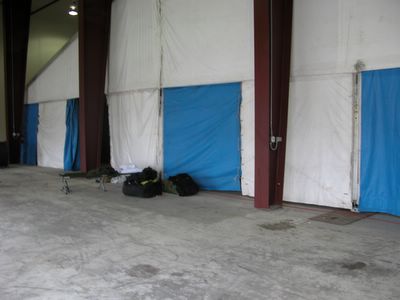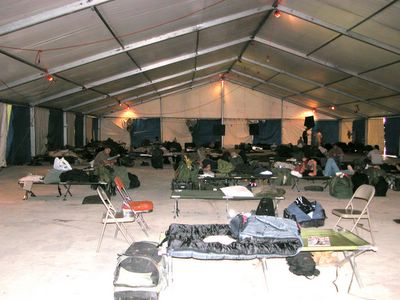Communications Specialist Adele Stan, together with the M.O.R.E. team of Issues Mobilization Specialist Brendan Danaher, and Health & Safety Specialist Milly Rodriguez, were sent to Baton Rouge, Louisiana, in mid-September to assess the needs of AFGE members--those affected by Hurricane Katrina, and those deployed in the disaster relief efforts. These are their blog entries.Prison in transit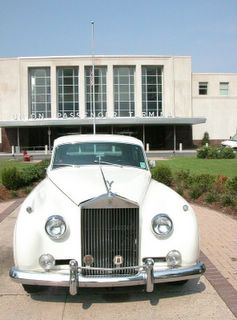 photo by Brendan Danaher for AFGEBy Rolls, by bus, by rail--it's now a jail.
photo by Brendan Danaher for AFGEBy Rolls, by bus, by rail--it's now a jail.NEW ORLEANS, LA--Before we set out for New Orleans, we received many dire warnings about checkpoints we might not get through. Brendan and Milly had gotten clearance from FEMA to pass into town, but I was along for the ride with the admonition that my press pass would do me more harm than good.
Less than an hour south of Baton Rouge, which had survived Katrina virtually unscathed, New Orleans’ brutal battering became ever more evident as we drew closer to the city. Soon the roadside was flanked by woods rendered naked by wind and rain; trees stood looking as if a fire had torn through the land which now bore little more than their roots and bare trunks. What branches were left were reduced to mere stumps.
Roofless buildings spoke of the beating they’d endured. Even the billboards--the few still standing--had been stripped of their ads, the paper having curled off of them in strips.
We never passed a working checkpoint before entering the city, so we headed directly for the Union Passenger Terminal (a.k.a., the Greyhound bus station) which, we had been told, was in use as a makeshift prison. Our mission was to locate the correctional officers from the federal Bureau of Prisons (BoP) who were helping state and parish officials run what was now the relocated Angola correctional facility.
A pair of National Guardsmen from Puerto Rico greeted us as we approached the station on foot, having parked the rental car in a bus stop where busses no longer stopped. They were kind and happy to see us, especially Milly, who had been to their island. The three exchanged a few words in Spanish, and everybody smiled.
Outside the front doors of the facility sat an odd collection of upholstered furniture and office chairs. These apparently served as a smoking lounge. “I wonder what that Rolls is doing there,” Brendan said. Inexplicably, a white Rolls Royce sat on the lawn--shiny and tidy in a scene of forlorn neglect.
We walked through the
al fresco lounge, an African-American worker held open the door for us. A manager from the Department of Justice stepped out from the stationmaster’s office, where he and a colleague had set up shop. A mobile featuring a cardboard replica of a Greyhound coach hung in the corner of by the window that looked onto the lobby. Once apprised of the purpose of our visit, he set out to find the warden on duty.
We met the deputy warden at the borderline between office and prison, which seemed to be marked by a set of glass doors that led to where the bus stalls were. It was there, presumably, that the inmates were housed. The bus station lobby--a broad expanse of terrazzo floors and aluminum trim with a wrap-around mural--appeared to be where the administrative work was done. People sat at computers in the middle of the waiting room, in a section marked off by yellow police tape.
Beyond the yellow perimeter, lining one wall and spilling out on a row of racks set perpendicular to the wall, were piles of colorful comforters and clothing. Nearby sat a garbage bin emblazoned with the motto, “Trash your city, trash yourself.”
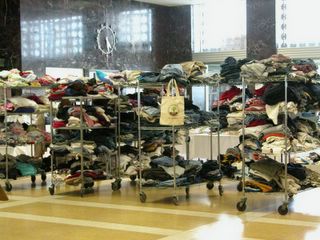 photo by Adele M. Stan for AFGEItems collected for working officers who themselves lost everything.
photo by Adele M. Stan for AFGEItems collected for working officers who themselves lost everything.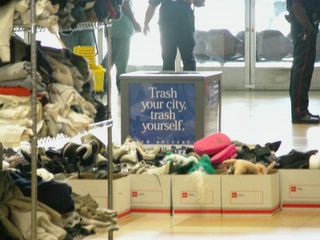 photo by Adele M. Stan for AFGE
photo by Adele M. Stan for AFGE“Those are for our sheriffs and their families,” said the DoJ manager. It was a story commonly heard throughout our trip; so many of the people doing the work of keeping order and performing rescue and relief were people who, themselves, had lost everything, or very nearly so.
Before we even got to the warden, a young guard employed by the State of Louisiana , white with a Marine-style haircut, began insisting that this one and that one would want to see us--all state and parish officials. We tried explaining that we were advocates for
federal workers, but it was to no avail. Once they learned that Milly’s specialty was health and safety, they were all over her.
The young deputy with Native American looks and a French name insisted that his boss would love to talk to us. He explained that most of the correctional officers on site were employees of the state, and that the BoP officers were detailed primarily to prisoner transport.
Soon a doctor in scrubs, a tall, wearing-looking white man in his fifties, rushed up to tell us he desperately needed medicine. He ran the clinic on this site, he explained, serving not just the inmates, but many of the rescue and law enforcement folks, as well as National Guard. He was handling the preventive care for a number of these workers--the vaccinaitons and antibiotics--in addition to treating their occupational injuries. “When folks learn there’s a clinic here, they come,” he said. “I don’t want to turn anyone away.” And he really needed more medicine, he told us. Milly promised to pass his request on to the FEMA officials that she and Brendan had met with.
Asked for the most common injuries he saw, the doctor listed a litany of the sorts of things that appear minor on the surface, but can be debilitating or even deadly if left untreated. Among the former are poison ivy, all manner of dermatitus, and red ant bites. The latter include cuts, puncture wounds and bacterial bronchitus, an increasingly common complaint among those working on the stench-filled streets and fetid waters of New Orleans.
We bade the doctor and the warden good-bye and turned for the door. “I really need medicine,” the doctor said.
 Katrina's wrath in New Orleans
Katrina's wrath in New Orleans The Katrina Files
The Katrina Files







